SDVoE™ Semiconductor Solutions for KVM Switches
Semtech’s award-winning BlueRiver® technology for Professional AV, or Pro AV, is used in KVM switches, which allow computer operators to control multiple devices with one set of operational equipment (keyboard, video, mouse). BlueRiver enables low cost KVM over IP applications with simple integration into third party KVM software systems. Support for fully networked KVM switching allows powerful applications such as single operator control of multiple computers with one set of USB peripherals.
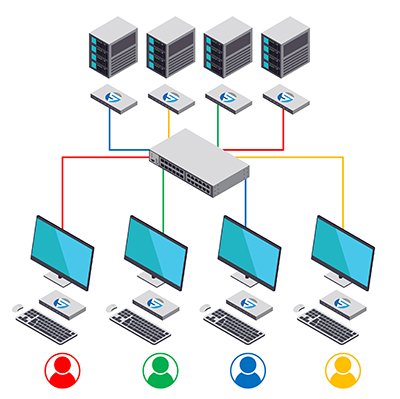
KVM Point-to-Point Switching
The most common KVM application is point-to-point switching and routing for secure remote desktop applications. This allows users to sign in to any KVM workstation and remotely connect to a dedicated PC host, secured in an equipment room to prevent unauthorized access. This architecture is typically used in command-and-control center applications, where sources are in a machine room to decrease clutter and environmental noise.
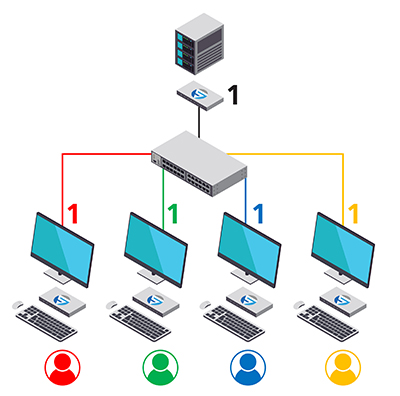
Collaboration
By connecting multiple KVM workstations over an IP network, a single PC can be subscribed to all users to allow collaboration on a single desktop. For example, in a classroom environment, students may be asked in turn to select answers to a quiz on screen that they are all observing simultaneously. Using simple software control, teaching staff can enable and disable the individual student participation.
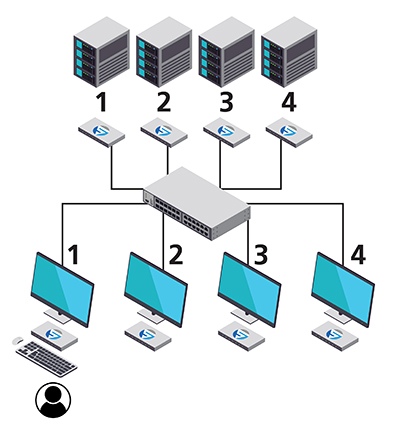
Dynamic Switching
Since all USB control data is sent as IP packets over the 10G network, more advanced KVM applications which require dynamic switching and control using third-party KVM software can be realized. In this example, a single user (or power user) can dynamically control multiple hosts. By simply moving the mouse across the multiple displays, the KVM server intelligently switches between the four remote PCs.
Power User
Looking at the power user application in more detail, as the diagram shows on the left, the video output and USB of each remote PC is connected to an AVP-based transmitter. The video output of each remote PC is then routed over the 10G network to a dedicated receiver connected to a workstation display. The AVP-based receiver at the bottom right has the keyboard and mouse connected via USB. Utilizing the SDVoE API, third-party KVM software can subscribe each video feed from transmitter to receiver, while also connecting each USB host and device to the KVM server IP address. The KVM software can now take control of the system of all USB traffic switching and routing, and by detecting the mouse position, can determine when to switch user control from one remote PC to another. For example, as the user moves the mouse to the right edge of display 1, USB control is switched from remote PC 1 to PC2. As the mouse is moved hard right to the edge of display 2, the USB control is dynamically switched from remote PC 2 to PC 3.
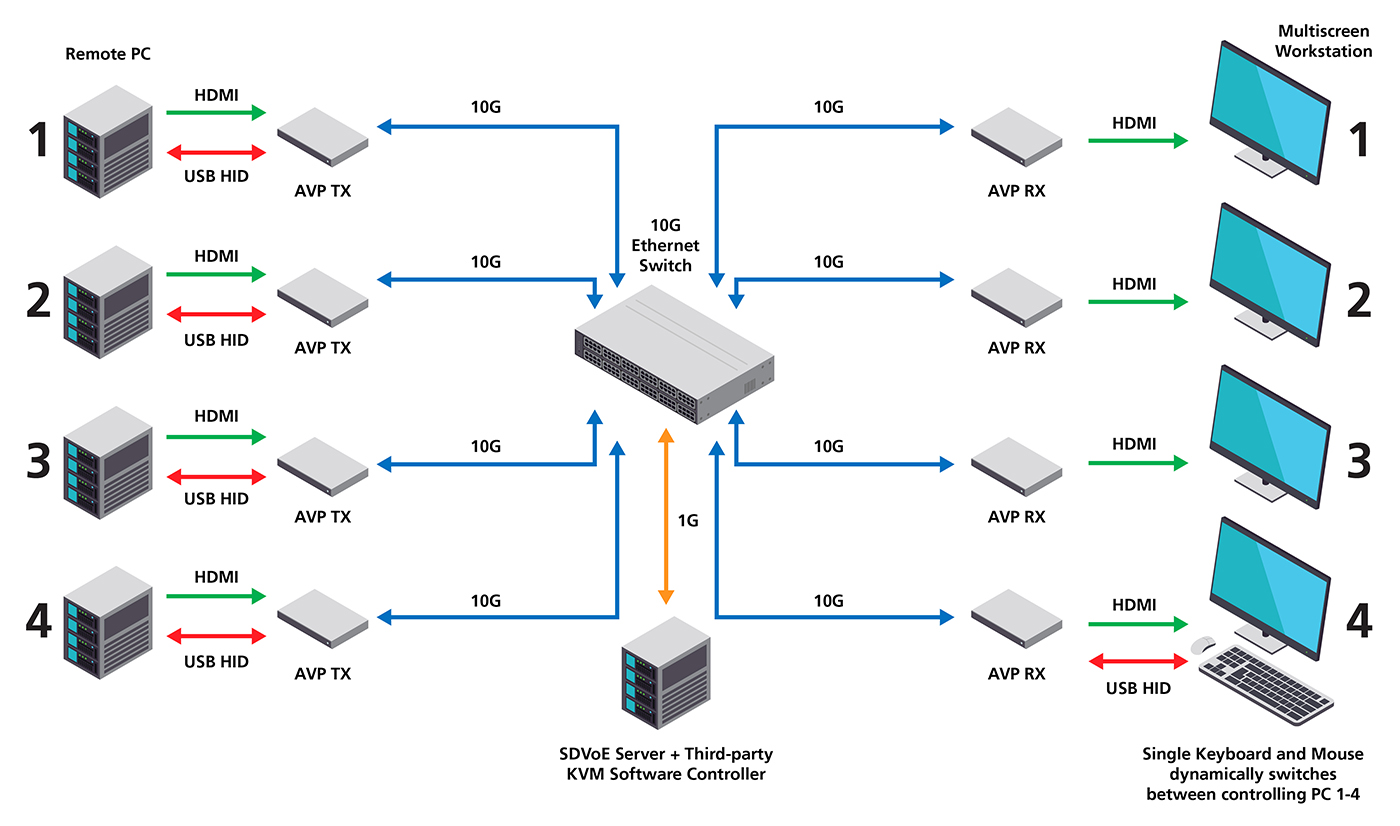
Figure 4. Power user application example using AVP-based transmitters and receivers via a SDVoE server and third-party KVM software controller.
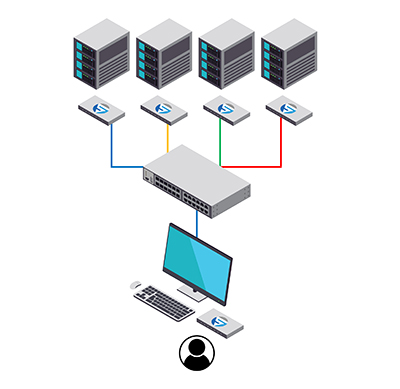
Figure 5. Remote desktop dynamic switching
Remote Desktop
Many environments need to optimize floor space and physical workstation sizes, allowing companies and organizations to reduce their building costs and environmental footprint. By simplifying workstations to just a single display with a mouse and keyboard, servers and desktop PCs can be kept in a dedicated secure and IT-controlled room, and accessed via the networked remote desktop, as shown in the diagram. Other benefits of this remote desktop architecture include reduced noise levels in the workspace since there are no more noisy fans, and physical security of PC’s to prevent unauthorized access or tampering. Both building management and IT departments benefit from AVP-enabled KVM over IP systems.
Comprehensive reference designs are available so KVM system designers can evaluate the performance of a typical remote desktop or workstation powered by Semtech’s BlueRiver devices. The diagram below illustrates a simple set up using two RDK-AVP2000T reference design kits, one configured as a Transmitter with local USB, and one configured as a Receiver with remote USB. Configuration and control is provided using a combination of the powerful SDVoE API and Semtech’s Pro AV Controller software evaluation tool.

Figure 6. Simple set-up using RDK-AVP2000T reference design kits, with one configured as a Transmitter with local USB, and the other as a Receiver with remote USB. The SDVoE API and Semtech’s Pro AV Controller software evaluation tool together provide configuration and control.
Inside the Box with AVP1000: A Powerful and Seamless KVM Switching Solution
Low latency performance is key to KVM applications, where hand to on screen mouse movement reaction time needs to be imperceptible to the user. The speed of 10G networking combined with the lowest latency AVP1000-based products, provides the ideal solution for powerful and seamless KVM switching with only a handful of major components. Alternatively, the AVP1000 can be paired with a standard SFP+ optical module to support 10G over fiber connectivity. Alternatively, the AVP1000 can be paired with a standard SFP+ optical module to support 10G over fiber connectivity.
Figure 7. This AVP1000-based transmitter delivers powerful and seamless KVM switching with only a handful of major components.
Mouse to screen lag becomes noticeable by the user at around 50ms of latency, or delay. With a combination of both AVP1000-based Transmitters and Receivers, sub-millisecond end-to-end latency is guaranteed, ensuring operators see no lag between moving their mouse or typing and on-screen response. In power user applications, switching between hosts is also seamless due to the speed and power of 10G Ethernet networking.
Figure 8. Using a combination of AVP1000-based transmitters and receivers ensures sub-millisecond end-to-end latency.
Discover our semiconductor solutions for your Pro AV needs.
KVM Switch Recommended Solutions
- BlueRiver for SDVoE
- Circuit Protection
Related Resources
Videos
